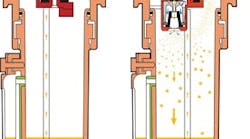In brief:
- Compressed air is used to power tools or actuators in a variety of manufacturing, processing, packaging and warehouse operations.
- While in an ideal world each production line would have one central lubricator serving all pneumatic devices, this is impractical in reality.
- There are two types of aerosol methods — high delivery systems (oil-fog) and low delivery systems (micro-fog) — for lubricating compressed air equipment.
Compressed air is used to power tools or actuators in a variety of manufacturing, processing, packaging and warehouse operations to push, pull, lift, position or convey. But the air leaving the compressor is not ready to power this equipment without proper preparation. Water and contaminants can cause damage and shorten the life of downstream equipment. Even sealed, pre-lubricated components run into problems when contaminated air washes out lubrication prematurely.
[pullquote]Filtering, regulating and lubricating the air stream delivers clean, dry air at the correct pressure for the equipment it is powering while lubricating it at the same time. Proper air preparation consisting of a filter, regulator and lubricator (FRL) is the best way to ensure optimal performance, minimize wear, and lengthen service life of equipment — even pre-lubed components — powered by compressed air. Appropriate lubrication can also help to reduce power consumption and operating costs by preventing wear that can impair performance.
While in an ideal world each production line would have one central lubricator serving all pneumatic devices, this is impractical in reality. Not every tool or device has the same consumption, nor will they all be working simultaneously. This means the oil delivery must be set at either a maximum demand (highest flow) or an average figure, resulting in cycles of both over- and under-lubrication, leading to increased wear and higher costs compared with individual or locally grouped lubricators.
Figure 1. Two types of aerosol methods — high delivery systems (oil-fog) and low delivery systems (micro-fog) — can be used for lubricating compressed air equipment.
There are two types of aerosol methods — high delivery systems (oil-fog) and low delivery systems (micro-fog) — for lubricating compressed air equipment (Figure 1).
Pneumatic systems requiring heavy lubrication, such as a single air tool or a single cylinder, benefit from oil-fog delivery systems. However, in this high delivery system, the oil aerosol produced contains relatively large oil particles, which are affected by gravity, making this system unsuitable for lubricating a device at a higher level than itself or at a distance away. As a general rule, the maximum distance this type of lubricator should be placed from the device it is to service is 9 m, at the same or a slightly higher level.
With low delivery or micro-fog systems, the airborne aerosol contains only light particles, less than about 2 µm diameter, meaning they can not only travel uphill but also for longer distances and through more complex feed lines without wetting out in the pipe. This system type can also ensure even distribution through multiple lubrication outlets, making it ideal for multiple valve control circuits. The smaller particle size makes low delivery systems most suited to applications where very small amounts of lubricant are required.
Both system types include a non-return valve in the siphon tube to ensure immediate lubrication as soon as the air supply is turned on. However, for some rapidly cycling applications or systems with small stroke cylinders, it is sometimes impossible to lubricate correctly with these conventional lubricators. Here, system modifications such as quick exhaust valves or a suitably located bi-directional lubricator must be employed.
Most aerosol lubricators are constant density devices, meaning once the drip rate is set for a given flow, then the amount of oil delivered will also change in direct proportion to any changes in flow rate. This prevents over- or under-lubrication to ensure even wear and minimum energy loss.
| Bradlee Dittmer is product marketing manager at Norgren (www.norgren.com/us/industrialautomation). Contact him at [email protected]. |
Whichever type of aerosol lubricator is employed, it must be remembered that all lubricators are “total loss” systems with the dispensed lubricant reaching its bearing surface and then breaking down into smaller particles that cannot be collected and reused. The system should be adjusted and maintained to use the minimum of lubricant required for efficient operation.
The amount of oil to be delivered to a pneumatic system to provide sufficient lubrication is difficult to determine, as all systems differ. Different pneumatic devices may require different amounts of lubricant, and so equipment manufacturers’ recommendations should always be followed. As a general guide, an oil output density of 60 mg/m3 is a good starting point. Regular inspection and servicing will reveal premature wear, in which case the oil output should be increased. If excess oil is observed, output should be adjusted downward.
Selecting the right aerosol lubricator and optimizing oil output will prolong equipment life and lower operating costs.
